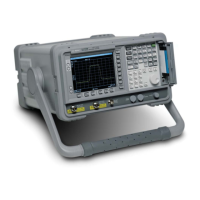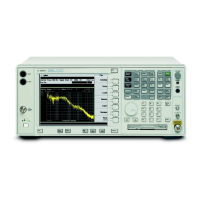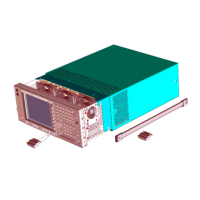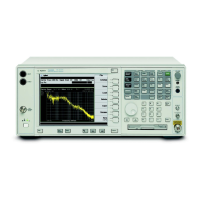80 Chapter 2
Front-Panel Key Reference
BW/Avg
Average
On Off
Initiates a digital averaging routine that averages the trace points in a
number of successive sweeps resulting in trace “smoothing”. The
number of sweeps (average number) can be selected. Increasing the
average number will further smooth the trace. The type of averaging
used is selected by pressing
BW/Avg, Avg Type.
The average is restarted when any of the following occurs:
• a new average number is entered.
• any measurement related parameter (e.g., Center Frequency) is
changed.
•
Restart is pressed.
•
Single Sweep is pressed.
When in Single Sweep, the specified number of averages is taken, then
the sweep stops. When in continuous sweep, the specified number of
averages is taken, then the averaging continues with each new sweep
averaged in with a weight of and the old average reduced
by multiplying it by .
To turn off averaging, press
Average (Off). The number of sweeps can
only be entered using the numeric keypad, not the knob or step keys.
Key Access:
BW/Avg
Avg Type
Auto Man
Accesses the functions to automatically or manually choose from one of
the following averaging scales: Video or Power (RMS).
NOTE If video averaging is selected, the measurement results are the average
of the signal level in the y-axis scale. If the power average (RMS) is
selected, all measured results are converted into power units before
averaging and filtering operations, and converted back to decibels for
displaying. The main point to remember is that there can be significant
differences between the average of the log of power and the log of the
average power.
There are actually four types of averaging processes within a spectrum
analyzer. All, except VBW filtering, are affected by this setting. They
are:
• Trace averaging (see
BW/Avg).
Averages signal amplitudes on a trace-to-trace basis. (Press Video or
Power (RMS) when
Avg Type (Man) is selected.)
• Average detector (see
Detector, Average).
Averages signal amplitudes during the time or frequency interval
represented by a particular measurement point.
• Noise Marker (see
Marker, Noise)
1
Average Number
-----------------------------------------
Average Number
1
Average Number
-----------------------------------------–

